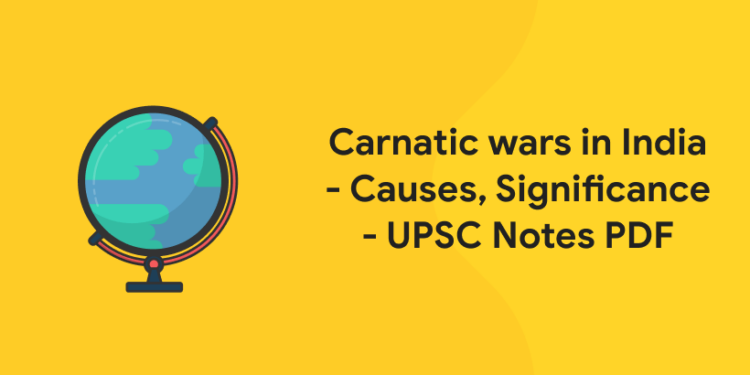Table of Contents
The Carnatic Wars were a series of military confrontations in India’s coastal Carnatic region, a dependency of Hyderabad State, in the middle of the 18th century. Between 1746 and 1763, three Carnatic Wars were fought.
The conflicts included a diplomatic and military fight between the French East India Company and the British East India Company, as well as struggles over succession and territory. They were mostly fought within Mughal India’s borders, with the help of a smattering of polities loyal to the “Great Moghul.”
The British East India Company developed its dominance among the European commercial corporations in India as a result of these military battles. The French enterprise was cornered and forced to confine itself to Pondicherry. The British Company finally took control of most of India as a result of the East India Company’s dominance, and the British Raj was established.
Grab Latest GK Study Materials! Register Here!
First Carnatic War (1746-48)
In South India, the Anglo-French rivalry erupted in full force. Karnataka was thrust into the spotlight. South Indian affairs at the time, particularly the internal situation in Karnataka, gave a chance for both nations to test their strength. Many tiny states had emerged in the south, taking advantage of the Mughal Empire’s weakness. There was once a fight between these two countries. Both the British and the French hoped to create their own dominance by taking advantage of this circumstance. In 1740 AD, the Austrian succession war began at the same time. This war reverberated throughout the British and French empires. This was likewise the case in India. The struggle between the British and the French began here as well. “The First War of Carnatic was essentially an extension of the Austrian War of Succession,” according to one historian.
First Carnatic War: Causes
1: Who was the first woman President of India?
The Carnatic War began when the British navy took possession of some French ships. To oppose the British, Dupleix (the French governor of Pondicherry) sought assistance from La-Boué (the French governor of Mauritius). He quickly sought Dupleix’s assistance with the troops. He quickly joined the army in coming to Dupleix’s rescue. Both moved to Madras, the seat of British power in India’s south.
The French defeated the British in the Naval War along the way. When the French commander arrived in Madras, he besieged the city and took many British prisoners, including Clive. La-Boudon wanted to recover damages from the British and return them to Madras, but Dupleix objected and retook control of Madras, which La-Boudon had given to the British for 4 lakh pounds. On September 17, 1746, this incident occurred. The British and Dupleix Fort St. Devitt tried unsuccessfully to take Pondicherry.
Dupleix’s acquisition of Madras discouraged the British. They sought assistance from Anwaruddin, the Nawab of Carnatic, who was upset by both companies’ wars and ordered both companies to cease fighting. However, Dupleix fraudulently informed the Nawab that he was fighting for the Nawab of Madras and won the battle. The Nawab went deafeningly quiet. Dupleix broke his word and pocketed all of the loot for himself, as well as his control over Madras. The Nawab of Carnatic, enraged, dispatched his troops to attack Madras. Dupleix was not discouraged.
At a site called St. Tomé, a combat took place between the two armies (Thomi). Captain Paradise beat the Nawab’s army with just 230 French and 700 Indian soldiers, demonstrating the’superiority of the foreign European disciplined army over the loose and undisciplined Indian force.’ Similarly, the Treaty of Aix-la–Chapelle in 1748 AD put an end to Austria’s succession conflict. As a result, the British and French reached an accord in India, and the war came to an end. Madras was returned to the British, while the French were given the territory of Luiburg (Luber) in North America.
Grab Latest GK Study Materials! Register Here!
Free UPSKILLING Courses!
Take your first step toward mastering in-demand skills, acing interviews, and securing top-tier jobs with Entri's free upskilling courses.
Start Learning!First Carnatic War: Significance
Although the First Carnatic War had nothing to do with Indian politics, its impact on India could not be overlooked. The European nations were made aware of the hollowness of Indian politics and military impotence throughout this war. The Carnatic Nawab was unable to prevent a commercial business from going to war. Not only that, but a small contingent of French forces beat the Nawab’s army. The loss of the Nawab prompted European nations to step up their involvement in Indian politics. Prof. Dr. Jewell emphasizes the significance of this war, stating that “it laid the ground for Dupleix’s experimentation and Clive’s works.” European forces, not just commerce, were now competing for political supremacy. “They practically jumped from the position of the submissive to the one of the lord,” Mallison writes.
Grab Latest GK Study Materials! Register Here!
Second Carnatic War (1749-54)
The Treaty of Aix-la-Chapelle put an end to the Anglo-French rivalry and allowed trade to resume, but the peace was short-lived. Both powers quickly began hunting for a suitable occasion. Dupleix’s political ambitions were sparked by the First Carnatic War. He grew obsessed with establishing French dominance in India. The British were in a similar situation. This chance occurred as a result of the contentious succession to the Hyderabad and Carnatic thrones.
Second Carnatic War: Causes
- The death of Nizam-ul-Mulk, the founder of the independent kingdom of Hyderabad, in 1748, and the release by the Marathas of Chanda Sahib, the son-in-law of Dost Ali, the Nawab of Carnatic, in the same year offered the chance.
- Muzaffar Jang, the grandson of the Nawab, challenged Nasir Jang, the son of the Nizam, to the throne of Hyderabad, claiming that the Mughal Emperor had designated him as the governor of Hyderabad.
- Two contenders for the Nawabship of the Carnatic, a subsidiary seat officially dependent on the Nizam, ran further south.
- After Nizam-ul-Mulk was obliged to interfere to restore order in the region, Anwar-ud-Din was made Nawab of the Carnatic in 1743.
- One of the Nizam’s officers was Anwar-ud-Din.
- Chanda Sahib objected to Anwar-ud-appointment. Din’s
- Chanda Sahib was the son-in-law of Dost Ali, a previous Carnatic Nawab (1732-39).
- Before being besieged by the Marathas in Trichinopoly in 1741, he had been an effective ally of the French.
Grab Latest GK Study Materials! Register Here!
Free UPSKILLING Courses!
Take your first step toward mastering in-demand skills, acing interviews, and securing top-tier jobs with Entri's free upskilling courses.
Start Learning!Second Carnatic War: Significance
In terms of results, the second Carnatic war was more important than the first. According to Sunderlal, this is the rock that destroyed Dupleix’s and the French’s dreams inside the country. The British now have a stronger position than previously. This war exposed the native rulers’ political hollowness to foreigners for the first time, allowing them to freely participate in Indian politics.
Third Carnatic War (1758-63)
The Anglo-French rivalry in India did not stop with the Second Carnatic War. Despite having to negotiate a humiliating pact with the English, the French were not demoralized and were searching for a chance. In India, the two powers clashed once more with the start of the Seven Years’ War in Europe (1756 AD). The British’s victory against Bengal (at the Battle of Plassey) had strengthened their position by this time (1758 AD). As a result, with double the might and resources, the British were determined to drive the French out of India.
Arrival of Count Lally
In 1757 AD, the French government dispatched Count Lally to India to preserve French interests and reclaim lost authority and prestige. In 1758, he arrived in India. He was a bold, daring, and talented general, yet he was also enraged and obstinate. He tended to make snap decisions based on his passion. As a result, he had to pay for himself as well as his country’s interests.
Lally stormed and took possession of the fort of St. David as soon as he arrived in India. After that, he sent his troops against Tanjore’s monarch. The French Company owed the Raja of Tanjore 56 or 70 lakh rupees, which he demanded back. As a result, he launched an attack on Tanjore. Lally was forced to withdraw his cordon and return due to British interference. The French will suffer as a result of this.
Faced with defeat at Tanjore, Lally devised a plan to attack Madras in the British war’s south, which was already being resisted by some of his colleagues. He also requested assistance from Bussi in Hyderabad. It was a huge blunder on Lally’s part. The French position in Hyderabad suffered as a result of this. Madras was besieged by the French troops in 1758 AD. Clive despatched Colonel Ford to Madras to deal with the situation, and he took Machilipatam. A deal with the Nizam of Hyderabad also helped the British reinforce their influence. Meanwhile, a second fleet came to assist the British. As a result, in 1758 AD, Lally was forced to break his siege on Madras.
Lally’s position was severely damaged by these occurrences. He lacked sufficient finances and was unable to obtain appropriate assistance from the domestic government. Despite this, Lally continued to fight the British on a periodic basis. The pivotal battle of Bandiwash, in which the British general Ayerkoot defeated the French and arrested Bussi, took place in 1760. The conflict, according to Mallison, the huge building to which Martin, Maas, and Dupleix had contributed, shattered all of Lally’s dreams and devastated Pondicherry’s fate.
In desperation, Layli sought support from Hyder Ali, the ruler of Mysore, but Hyder Ali backed down at the last moment, promising assistance. To revenge Madras, the British besieged Pondicherry. Lally battled the British valiantly, but after an eight-month siege, he was forced to surrender in 1761. The British took control of Pondicherry. Mahi and Jinji were also apprehended.
Grab Latest GK Study Materials! Register Here!
Third Carnatic War: Causes
The Seven Years’ War broke out in Europe in 1756, pitting Britain and France against one other once more. As a result, the English and the French fought the Third Carnatic War in India. In 1756, however, there was no engagement between the two. In 1757, they began targeting each other’s property. The French were successful in taking a major portion of Karnataka, but they were unsuccessful in seizing English strongholds such as Trichinopoly, Arcot, Madras, and St. David. In the north, the English had more success. They seized all of the French’s main locations in Bengal and Bihar.
The greatest battles between the two companies began in 1758, when Count de Lally arrived in India as both the leader of the French armies and the Company’s governor. Lally was an accomplished and fearless commander. But he had a pompous demeanor and was a natural idealist. As a result, despite his initial success, he ultimately failed. He captured St. David as soon as he arrived in India. He then planned to assault Madras, but the governor of Pondicherry was unable to fund the attack, and Count de Ache refused to attack Madras by sea. Lally then invaded Tanjore in the hopes of obtaining some booty, but was forced to retreat when the English force arrived to confront him. Meanwhile, de Ache was defeated at sea by the English and forced to retreat to Mauritius with his ships, much against Lally’s intentions. Lally, on the other hand, besieged Madras in 1758. He remembered Bussy from Hyderabad and thanked him for his assistance. However, he was not successful. With the departure of Bussy from Hyderabad, the French influence in the city faded. Bengal provided reinforcements to the English. In 1759, Lally was obliged to raise the siege of Madras.
Grab Latest GK Study Materials! Register Here!
Third Carnatic War: Significance
The Third Carnatic War was a decisive victory. The Treaty of Paris (1763) brought an end to the third war, allowing Pondicherry and Chandannagar to be ceded to France but solely for commerce purposes. Despite the fact that the treaty restored the French factories in India, French political power in India faded after the war.
Following that, the French in India, like their Portuguese and Dutch counterparts, restricted themselves to small enclaves and commerce. In the Indian subcontinent, the English became the dominant European power.
Carnatic wars in India: UPSC Notes PDF
Download Carnatic wars in India – UPSC Notes PDF
I hope you found this article useful. The secret to clearing an exam is to prepare methodically and strategically. If you’re a candidate looking to start your dream job but don’t know where to start, our Entri app has you covered. Our staff will provide you with content and insights on the topics that affect you. Become a member of our app today and enroll in one of the many programs available. Stay up to date on various elements of the subject you’re interested in by using the app. Please feel free to leave any questions or concerns in the comments area. We will make every effort to reach back. Remove any self-doubts and negative thoughts from your mind. Make an effort to maintain a clear viewpoint. Consider why you desire this. Concentrate on the positive aspects of your situation and work diligently. Each day is a valuable gift that has been placed upon us, so make the most of it. Make an effort to improve yourself. Today is the day; let’s hope it goes well. Best wishes.











